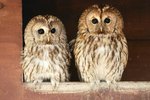
The relatively small burrowing owl stands about 8 inches tall and weighs just slightly more than 5 pounds as an adult. These little owls build their nests underground, as their name suggests, in the abandoned burrows of rodents and reptiles. The burrowing owl's life cycle begins when the birds mate in late winter or early spring, with last year’s hatchlings ready to find sweethearts of their own during this year’s mating season. The burrowing owl's lifespan is about eight years.
Sweethearts
The life cycle of the burrowing owl begins when a male owl and a female owl become a couple. For the most part, burrowing owls are monogamous, though some male owls will have two mates. The male owl coos, nips and does aeronautical stunts in a bid to get a female to pay him some attention. Once she does, the courtship moves quickly, and the owls are soon moving in together.
Nesting
The new couple may build their own burrow, but most often they take up residence in the discarded burrow of a rodent or reptile. They will spruce up the burrow with grass clippings and manure from other animals. Once she lays her eggs, the female owl is busy incubating and brooding. The male owl hunts for food and brings his mate's meals to her. The baby owls will hatch about 30 days after their mother lays her eggs. The clutch size averages about seven eggs, though it can be as large as 12.
New Arrivals
Once the babies hatch, mom stays with them while dad hunts for food for the family. The little owls will come out of the burrow two weeks to a month after hatching, but will go no further than the burrow's entrance for the time being. Now, both mom and dad will forage for food. The burrowing owl's diet consists of small rodents and reptiles, and insects.
Growing Up
By mid-summer, the spring's hatchlings are starting to fledge, meaning they are beginning to fly. This happens when the owlets are about 44 days old. In the beginning, they will only fly short distances from the burrow and their parents will continue to feed them. As they get to be stronger in their flight, they will begin to forage for food with their parents.
Fly Away
By early autumn, the spring hatchlings will get their adult plumage and will soon be ready to leave the nest for good. Burrowing owls in the southern United States will find their own burrows in which to spend the winter months. Northern burrowing owls will begin migrating. By February, the courtship routine will begin again, and the seasons will unfold with the cycle repeating itself.
References
Photo Credits
-
Comstock Images/Comstock/Getty Images
Writer Bio
Bethney Foster is social justice coordinator for Mercy Junction ministry, where she edits the monthly publication "Holy Heretic." She is also an adoption coordinator with a pet rescue agency. Foster spent nearly two decades as a newspaper reporter/editor. She graduated from Campbellsville University, receiving a Bachelor of Arts in English, journalism and political science.




